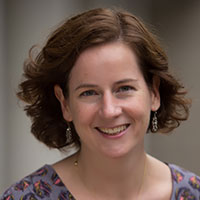Study finds higher risk of breast cancer for women after childbirth
December 11, 2018
Younger women who recently have delivered a child may have a higher risk of breast cancer than do their peers of the same age who have not delivered children, according to a large-scale analysis co-led by a UNC-Chapel Hill Gillings School of Global Public Health researcher.
The findings, published Dec. 11 in the Annals of Internal Medicine, may seem contrary to conventional wisdom that childbirth is protective against breast cancer.
Researchers say childbirth still does become protective, but it can take more than two decades for benefits to emerge. Breast cancer is more common in older women, with the median age of 62 at diagnosis in the United States. Researchers who led the study from the Premenopausal Breast Cancer Collaborative Group identified elevated breast cancer risk after childbirth in women younger than 55.
“What most people know is that women who have children tend to have lower breast cancer risk than women who have not had children, but that really comes from what breast cancer looks like for women in their 60s and beyond,” said Hazel B. Nichols, PhD, assistant professor of epidemiology at the Gillings School and member of UNC Lineberger Comprehensive Cancer Center. “We found that it can take more than 20 years for childbirth to become protective for breast cancer, and that before that, breast cancer risk was higher in women who had recently had a child.”
Other studies have shown an increase in breast cancer risk in younger women after childbirth, but have not had access to information about other factors that might impact risk, such as breastfeeding or family history of breast cancer, researchers said. For their analysis, researchers pooled data from 15 prospective studies from the around the globe that included 889,944 women. In addition to looking at breast cancer risk after childbirth, they also evaluated the impact of other factors, such as breastfeeding and a family history of breast cancer.
They found that, in women 55 years and younger, breast cancer risk peaked about five years after they gave birth, with risk for mothers 80 percent higher compared with women who did not give birth. Twenty-three years after giving birth, women’s risk leveled off, and pregnancy started to become protective. The increased risk after childbirth was higher for women who also had a family history of breast cancer or who had a greater number of births or were older at first birth. The pattern looked the same whether or not women breastfed.
“We need to recognize that the traditional risk factors for breast cancer do not always operate the same way at younger ages,” Nichols said.
While breast cancer risk increased for mothers after pregnancy, researchers also noted that the overall risk of breast cancer is still low in this group. Between the ages of 41 and 45, there were 41 more cases of breast cancer diagnosed in every 100,000 women who had given birth in the previous three to seven years, compared with women who did not have children. By age 50, there were 247 more cases per 100,000 women in the group that recently had given birth.
“In this age group, breast cancer is uncommon,” Nichols said. “The risk of developing breast cancer is still low overall, even if you’ve had a child five years ago.”
Their findings also were not the same for all younger women. Risk was higher for women who had their first child after 35, but there was no increased risk of breast cancer after a recent birth for women who had their first child before age 25. While pregnancy did become protective against estrogen receptor-positive breast cancer years later, it did not become protective for estrogen-receptor negative breast cancer during the study.
“This is evidence of the fact that just as breast cancer risk factors for young women can differ from risk factors in older women, there are different types of breast cancer, and the risk factors for developing one type versus another can differ,” Nichols said.
The study’s findings could be used to develop better breast cancer risk prediction models to help inform screening decisions and prevention strategies, Nichols said.
“Many ongoing studies are trying to improve our ability to do breast cancer risk prediction on the individual level,” Nichols said. “This is one piece of evidence that can be considered for building new prediction models.”
In addition, the study could lead to greater breast cancer awareness among young mothers and medical providers.
“We want women and their doctors not to assume that recently having a child is always protective for breast cancer,” Nichols said.
Co-leading the study with Nichols were Dale Sandler, PhD, senior investigator with the National Institute of Environmental Health Sciences, and Minouk K. Schoemaker, PhD, staff epidemiologist, and Anthony J. Swerdlow, DM, DSc, both with The Institute of Cancer Research in London.
The international effort included other co-authors from The Institute of Cancer Research in London; the Karolinska Institutet in Stockholm, Sweden; the University of Pisa (Italy); Boston University’s Slone Epidemiology Center; University of Paris; the Basque Regional Health Department (Spain); International Agency for Research on Cancer (France); Brigham and Women’s Hospital and Harvard Medical School; the Cancer Council Victoria (Melbourne, Australia); University of Tromsø (Norway); University of Massachusetts; Johns Hopkins Bloomberg School of Public Health; Division of Cancer Epidemiology (Heidelberg, Germany); University of Oxford; National Cancer Institute; Imperial College London School of Public Health; Cancer Registry (Norway); University Medical Center (Utrecht, Netherlands); Umea University (Sweden); Danish Center Society Research Centre (Copenhagen); Hellenic Health Foundation (Athens, Greece); Norwegian University of Science and Technology; National Institute of Environmental Health Sciences; and Arctic University of Norway.
Other Gillings School co-authors included Jianwen Cai, PhD, Cary C. Boshamer Distinguished Professor, and Jiawei Xu, BS, doctoral student, both in the biostatistics department.
A version of this article originally was posted on the UNC Lineberger Comprehensive Cancer Center website.
Contact the Gillings School of Global Public Health communications team at sphcomm@listserv.unc.edu.

